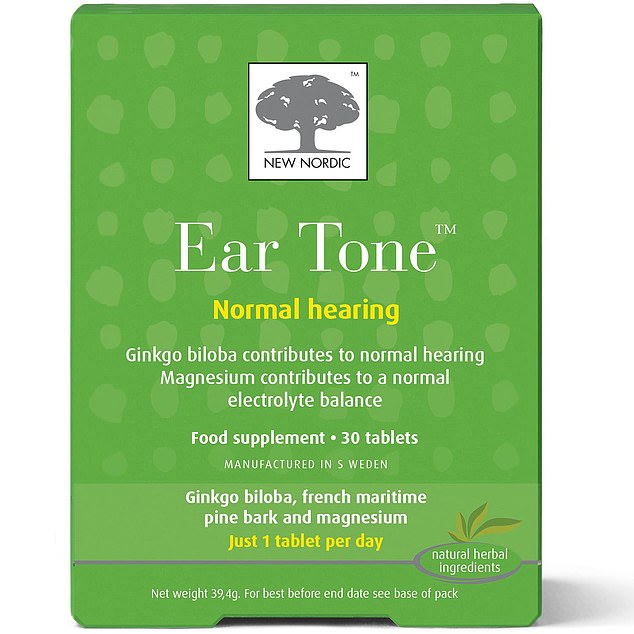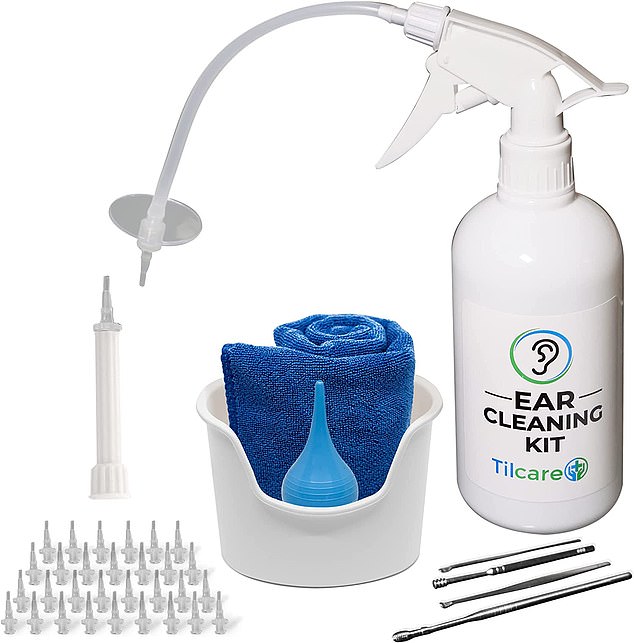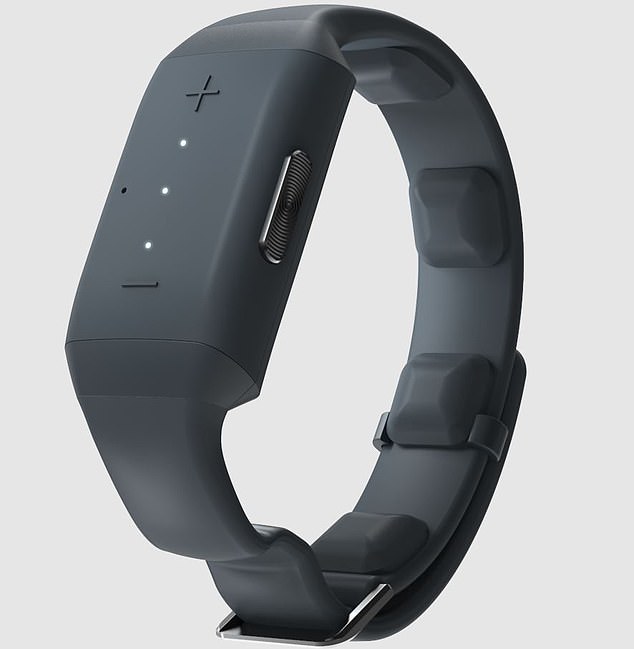ADRIAN MONTI: Could £400 glasses with subtitles help if you’re hard of hearing?
>
Almost one in five adults in the UK has hearing loss, yet only a third of those who could benefit from wearing hearing aids — roughly 6.7 million people, says charity Hearing Link — actually do so, typically for fear of looking old.
Whether you’ve got age-related hearing loss or are struggling to hear because of a cold, there’s a range of products available. Adrian Monti asked experts for their views on a selection, which we then rated.
Subtitle glasses
Xrai Glass, £400, xrai.glass
Claim: These smart glasses ‘turn speech into subtitles in real time’. A cable attaches the frame to the user’s smartphone so an app can convert spoken words into text projected on the inside of the lenses. Words are colour- coded so the user knows who is speaking.
Expert verdict: ‘I really like the look of these — they could be a great option for those with more severe to profound hearing loss,’ says Saima Rajasingam.
‘These frames could be a game-changer in terms of reducing the need for someone else to help the user be involved in a conversation and allowing some independence.
‘They would probably work best for a conversation in a quiet room, as a lot of voice recognition technology struggles in noisier settings.’
8/10

Xrai Glass
Volume booster
Echo MiniTechT, £108, hear4you.com
Claim: This device — slightly smaller than a standard smartphone — is described as a ‘portable personal listener’. It can be worn on a loop around the neck or with a headset and has a tiny microphone that amplifies sound while, for instance, ‘in meetings, out and about or television listening at home’ (it connects directly into the TV via a wire).
Expert verdict: ‘This device might help someone with conductive hearing loss [due to wax or an infection, for instance], where the issue is a blockage that’s affecting volume,’ says Lee Fletcher, an audiologist and co-founder of Regain Hearing, based in Kent and London.
‘It might improve conversation with one person in a quiet room — as long as there is very little background noise.
‘But amplifiers like this turn everything up and are much more of a blunt tool than a hearing aid, which can be programmed to each person’s particular hearing needs.
‘I would not recommend this device for the majority of people suffering from age-related hearing loss.’
4/10
Herbal tablets
New Nordic Ear Tone, 30 tablets, £25.99, hollandandbarrett.com
Claim: Said to ‘support your hearing function’, this supplement contains ginkgo biloba (extracted from the leaves of a tree found in China), which the maker says ‘contributes to normal hearing’.
It also contains extracts of French maritime pine bark that has chemicals said to improve blood flow, and magnesium to ‘maintain normal function of the nervous system’. Take one a day.
Expert verdict: ‘Taking supplements [for hearing loss] is highly unlikely to be effective, as the wear and tear on the inner ear hair cells that causes age-related hearing problems is permanent and they cannot regrow,’ says Lee Fletcher.
‘Any relief is likely to be because of a placebo effect.’
1/10


New Nordic Ear Tone
Ear clearer
Eustachi eustachian tube exerciser, £49.99, lloydspharmacy.com
Claim: This battery-operated device ‘helps clear your ears any time, anywhere using just a little air’. The maker recommends it for ears that are blocked because of flying, swimming or a cold or allergy.
Expert verdict: ‘Flying causes pressure in the outer ear to differ from the pressure in the middle ear, which can lead to a sense of fullness and occasionally pain,’ says Dr Saima Rajasingam, a lecturer in audiology at Anglia Ruskin University.
‘These pressure changes create a vacuum which seals the eustachian tube, which connects the middle ear with the back of the throat.
‘This device blows a gentle stream of air into the nostril on the side where the ear is blocked, which is then forced into the eustachian tube when you swallow — equalising the pressure in this part of the ear and getting rid of the blockage.
‘The science behind this device is sound but simply sucking on a sweet might be easier, cheaper and more enjoyable — it triggers swallowing, which re-opens the eustachian tube and equalises pressure.’
6/10
Off-the-shelf aids
Widersonic hearing aid, £129, hearing-health.co.uk
Claim: These fit inside the ear canal rather than sitting on the outside of the ear like traditional hearing aids.
An inbuilt microphone picks up sound and a microchip converts it into a digital code that’s changed back into soundwaves played through the aid’s speaker in the ear.
Designed for those with mild to severe hearing loss, they have a mechanism that ‘detects when someone is talking and suppresses background noise’.
Expert verdict: ‘NHS hearing aids are much more sophisticated than these, as they’re digital, better-fitting products that are programmed through computer software to match the hearing test result,’ says Lee Fletcher.
‘But there is a place for over-the-counter hearing aids like this — maybe for people waiting for NHS prescription ones to be available, which can take up to 18 months.
‘They’re more like a set of reading glasses that you just randomly pick up.’
4/10
Noise-blocking ear plugs
Loop engage plus ear plugs, £31.95, loopearplugs.com
Claim: These ear plugs ‘allow you to have conversations freely, offering 16dB [decibel] noise reduction without compromising sound clarity’, says the maker.
Expert verdict: ‘Repeated exposure to loud sounds, or one-off exposure to very loud sounds, can cause a permanent hearing loss by damaging the cells in the inner ear, which are responsible for detecting sound,’ says Saima Rajasingam.
‘These ear plugs are more expensive than disposable silicone plugs but they meet EU standards for hearing protection — not all disposable silicone plugs do.
‘However, they are not custom-moulded to the user’s ear — which they should be, to stop sound entering.
‘And, although they’re designed for everyday use, do take regular breaks when using ear plugs to allow air to ventilate your ears — a sealed, warm and humid ear is the perfect environment for an ear infection.’
6/10


Ear wax vacuum
Tilcare ear wax vacuum removal tool, £19.99, amazon.co.uk
Claim: ‘A safe and effective ear cleaning system that removes earwax blockages which can result in hearing loss, tinnitus, headaches and vertigo.’
You pour warm water into the spray bottle provided — then insert the long, thin tube attached to it into the ear to flush out ‘lodged ear wax, dirt and debris’. This kit contains a stainless steel curette to remove wax, a microfibre towel and 30 disposable tips.
Expert verdict: ‘This falls headlong into the ‘steer clear’ category,’ warns Lee Fletcher.
‘By blindly pushing this into the ear canal, you can cause abrasions, tear sensitive skin within the canal and even rupture eardrums. Only a medically trained hearing professional should perform wax removal.’
0/10


Ear wax vacuum
Hearing ‘gym’
Eargym, £3.99 a month, eargym.world
Claim: A smartphone app that provides ‘immersive training games to boost your listening skills’. The developer claims it can ‘train your brain to hear better’ by stimulating the ears and parts of our brain responsible for hearing.
The app features two games: one where you play the role of barista taking coffee orders against increasingly loud background noise; the other involves matching similar sounds which differ in volume, pitch and interval.
Expert verdict: ‘Auditory training like this app can improve our processing skills and make us better listeners,’ says Sonja Jones, an audiologist at Cardiff Hearing, an independent audiology practice.
‘This won’t reverse hearing loss but can help us to still be involved in conversations.
‘Apps like this can make us better at following speech in noisy settings or improve our tolerance of background noise.’
7/10
The bracelet that ‘feels’ sound
Neosensory Clarify, $999 (£822), neosensory.com
Claim: This wristband ‘improves hearing without the need to wear hearing aids’. It vibrates so high frequency sounds are felt as vibrations, which ‘re-trains the brain to better understand spoken words’, says the maker. Suitable for ‘people with mild to moderate hearing loss’ when high frequencies become harder to hear. Currently available only in the U.S.
Expert verdict: ‘The manufacturer has published a study involving 18 users (13 of whom had severe or profound hearing loss) who were able to correctly identify speech using only the wristband,’ says Dr Saima Rajasingam, a lecturer in audiology at Anglia Ruskin University.
‘I would be a bit cautious about generalising the potential benefit to everyone with hearing loss, but the initial results are promising.
‘I would see this as a supplement rather than replacement to hearing aids — but it’s very expensive.’
6/10


Neosensory Clarify
